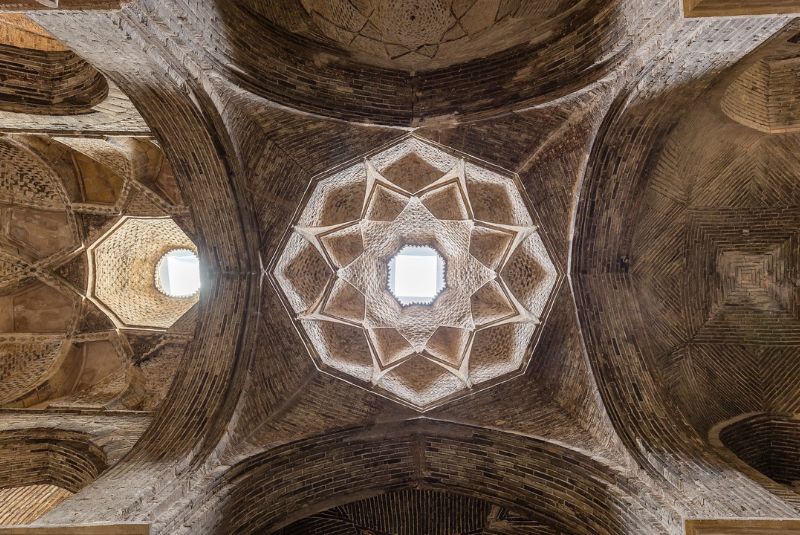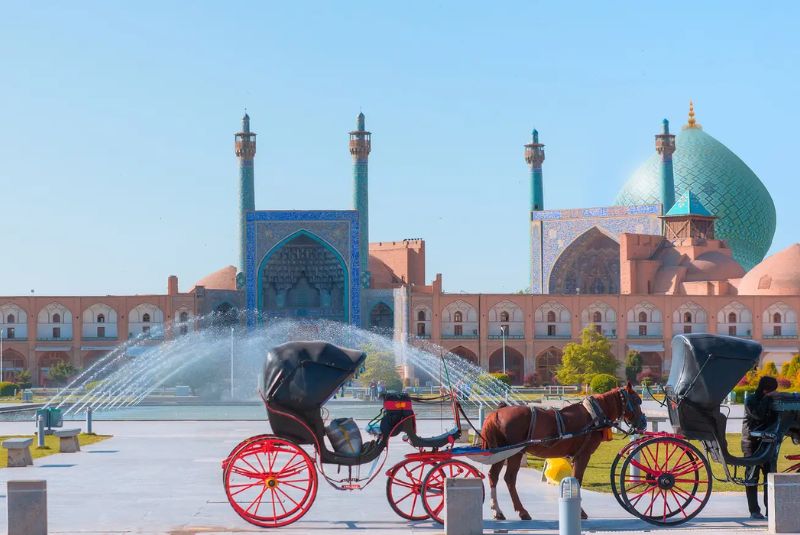Masjed-e Jame of Isfahan | History, Architecture, & Travel
Jame Mosque of Isfahan (مسجد جامع اصفهان), commonly referred to as the Friday Mosque (مسجد جمعه) or Atiq Mosque (مسجد جامع عتیق), is a distinguished monument situated in Isfahan, Iran.
Dating back to the 8th century, the mosque has undergone various architectural phases, reflecting the evolution of Persian art and design. Its central location in Isfahan underscores its prominence in the city's historical and cultural landscape.
Masjed-e Jame of Isfahan holds a significant position in Islamic era of Iran, being one of the oldest mosques in the country. It is recognized on a global scale, having attained the status of a UNESCO World Heritage Site.
Interested in visiting Jame Mosque of Isfahan?
Check out our Isfahan tour packages to find an itinerary that includes visiting the mosque
or...
Design your own tailor-made itinerary and include Isfahan's Jame Mosque in it by yourself, today!
History of the Jame Mosque of Isfahan

The Jameh Mosque's story stretches back far beyond its construction in 771 AD. Archaeological evidence, including a discovered pillar base, hints at pre-Islamic origins, suggesting a possible fire temple dating back to the Sassanid era (224-651 AD). While the exact foundation date remains a mystery, estimates place its initial construction around 2000 years ago.
Throughout its long history, the mosque has witnessed numerous transformations under different dynasties. The Abbasid Caliphate (750-1258 AD) saw the construction of the first mud-brick mosque in 771, followed by a larger structure with a prayer hall under Caliph al-Mu'tasim in the 9th century. The Buyid dynasty (932-1062 AD) added intricate brickwork and decorative elements, leaving their mark on the evolving structure.
However, the most significant transformation occurred during the Seljuq era (1037-1157 AD). Under visionary rulers like Malik Shah I, the mosque adopted the revolutionary four-iwan layout, now a hallmark of Iranian mosque architecture. Additionally, the construction of the Taj al-Mulk and Nizam al-Mulk domes showcased the Seljuks' architectural advancements, shaping the mosque's final outward appearance.
While subsequent dynasties like the Ilkhanids, Timurids, Safavids (1501-1736 AD), and Qajars (1789-1925 AD) made their contributions through additions and restorations, none replicated the transformative impact of the Seljuqs. Each era left its imprint, enriching the mosque's historical canvas and creating a unique tapestry woven over centuries.
| Related: Isfahan Mosques You Should Visit
Jame Mosque of Isfahan Architectural Features

Great Mosque of Isfahan architecture boasts a meticulously crafted design and layout that reflects the evolution of Persian architecture during Islamic era. Inspired by Sassanid palaces, its layout centers around four distinct courtyards, each leading to sections showcasing the distinct styles of different dynasties.
The defining feature is the four-iwan layout, introduced by the Seljuqs (11th-12th centuries). These grand vaulted arches frame the courtyards, acting as gateways to prayer halls, libraries, and other functional spaces. This innovative design embodies openness and accessibility, becoming a hallmark of Iranian mosque architecture.
Look for remnants of the Abbasid period (8th-9th centuries) in the simple brickwork and geometric patterns still visible in parts of the structure. These elements stand in contrast to the intricate tilework adorned with floral and geometric motifs introduced by the Seljuqs, showcasing their mastery of ceramics. The Safavids (16th-17th centuries) added their touch with vibrant tilework depicting floral arabesques and calligraphy inscriptions, enriching the visual narrative.
Gaze upwards to admire the architectural marvels. The ribbed domes, particularly the Taj al-Mulk and Nizam al-Mulk domes, showcase Seljuq advancements in construction and their pursuit of grandeur. Each dome is adorned with intricate tilework and calligraphy bands, a testament to their architectural prowess.
- Qibla Iwan (13th century): The southern qibla iwan boasts vaulted muqarnas decorations and is uniquely flanked by two cylindrical minarets.
- Öljaitü Mosque (1310): This side prayer hall houses an elaborately carved stucco mihrab commissioned by Mongol ruler Öljaitü, adorned with Quranic inscriptions and floral designs.
- Dome-chamber of Nizam ul-Mulk (1086–87): This domed chamber, reserved for the ruler, offers access to the main mihrab. Its construction showcases Seljuq architectural advancements.
- Soffe Darvish (1088): Located behind the northern iwan, this construction reflects the final major Seljuq alteration. While significantly remodeled, traces of its original design remain.
- Central Courtyard (circa 771 CE): This large, open-air space offers tranquility, with brick piers and columns supporting the roofing system and allowing prayer halls to extend outwards.
- Seljuk Domes (1086–87): The mosque's renowned brick domes include the south dome, built by Nizam al-Mulk to house the mihrab, and the north dome, built by Taj al-Mulk.
| Read more: Isfahan Traditional Bazaars
Great Mosque of Isfahan Materials
- The earliest parts of the mosque, dating back to the 8th century, were built from mudbrick. This was a common building material in the region at the time, and it is still used today in some parts of Iran.
- As the mosque was expanded and renovated over the centuries, brick became the most common building material. The bricks used in the Great Mosque of Isfahan are mostly fired bricks, which means that they have been heated in a kiln to make them stronger.
- Stucco was used to decorate the interior walls and ceilings of the mosque.
- Tilework is one of the most distinctive features of the Great Mosque of Isfahan. The tiles are made from fired clay, and they are decorated with a variety of geometric and floral patterns. The tiles were used to cover the walls, domes, and iwans of the mosque.
- Wood was used for some of the doors, windows, and ceilings of the mosque.
| Discover: Isfahan Historical Palaces
Masjed-e Jame of Isfahan Location and Access

Located in the historic quarters of Isfahan, Majlesi street, the Atiq Jameh Mosque stands in proximity to key tourist attractions:
- Chehel Sotoun Palace: A Safavid pavilion with a mirrored hall and beautiful gardens, offering a glimpse into Persian architecture and history.
- Naghsh-e Jahan Square: A UNESCO World Heritage site featuring Ali Qapu, Imam Mosque, Sheikh Lotfollah Mosque, and Qeysarieh Gate, showcasing the splendor of Safavid architecture.
- Hasht Behesht Palace: A historical pavilion surrounded by gardens, exemplifying Persian garden design and architectural finesse.
- Natural History Museum of Isfahan: A museum housing diverse exhibits on Iran's natural history, providing an educational experience.
- Contemporary Art Museum of Isfahan: A cultural institution showcasing modern and contemporary Iranian art.
- Ali Gholi Agha Hammam: A well-preserved historic bathhouse, offering insight into traditional Persian bathing culture.
| Also read about: Top 14 Religious Tourist Attractions in Iran
How to Get There:
- By Bus: The mosque is conveniently accessed by bus from Imam Ali Square. Opt for lines 47, 52, 53, or 71 for a drop-off right at the mosque. Utilize the Isfahan card for economical and flexible bus travel.
- By Taxi: Taxis, abundant throughout the city, offer a secure and affordable transportation option. Consider using rideshare apps like SNAPP or TAP30 for a convenient taxi experience.
- By Plane: Isfahan is well-linked to major cities such as Tehran and Mashhad via Isfahan International Airport (IFN), a brief thirty-minute drive from Masjed-e Jame. Shared taxis or rideshare apps provide economical transit.
- Public Transportation Network: Isfahan's well-established public transportation network, encompassing buses, trains, and metro, facilitates seamless travel within the city and to other urban centers.
| Discover: Top 5 Bridges in Isfahan over Zayanderud River
Visiting Jame Mosque of Isfahan

Masjed-e Jame welcomes visitors daily from 9:00 am to 12:00 pm and from 2:00 pm to 4:30 pm. To avoid crowds and the midday heat, it's recommended to explore the mosque in the morning. Ensure sufficient time for your visit, as the mosque closes to tourists at noon for the afternoon prayer. For a unique perspective, consider an evening visit and join locals in Naqsh-e Jahan Square for weekend picnics.
For an enriched experience, consider hiring a local guide who can provide insights into the mosque's history, tales of ancient rulers, and the architectural marvels within.
For independent visitors, a 30-minute stroll through the mosque is suitable. However, for a comprehensive exploration of intricate designs and historical significance, plan for a two-hour stay.
| Suggestion: Best Restaurants in Isfahan
Best Time to Visit Masjed-e Jame of Isfahan
April and May offer the most favorable weather for a visit to Isfahan, avoiding the peak season crowds.
How to Visit Jame Mosque of Isfahan
Remember that Masjed-e Jame is an active mosque; thus, visitors must be respectful:
- Women are advised to dress modestly, wearing a hijab, long sleeves, and long pants.
- Men should opt for long pants and avoid sleeveless shirts.
- Maintain a solemn demeanor, refraining from loud conversations and horseplay. The mosque, being sacred, requires adherence to etiquette.
- While photography is permitted, avoid capturing worshippers during prayer times.
Bottom Line
Masjed-e Jame of Isfahan stands as the oldest mosque in Iran, preserving narratives spanning a millennium and concealing secrets from centuries past. Its architectural marvel alone is compelling enough to captivate any visitor. The historical richness contained within its walls surpasses what one might discover in conventional literature. Collectively, these attributes transform this enchanting structure into a must-visit destination for everyone.
Share your story!
Comment below and let us know about your Experience.
Your story inspires others!


Comment
Leave a Comment